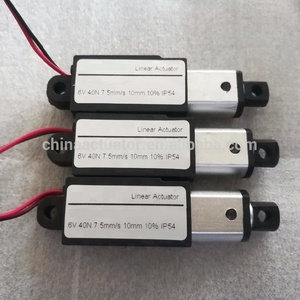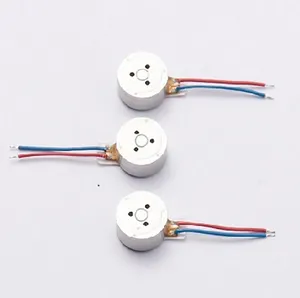
All categories
Featured selections
Trade Assurance
Buyer Central
Help Center
Get the app
Become a supplier

(845 products available)




















































There are several types of the smallest linear actuators available in the market today. They are based on how they generate the desired motion. They include.
Mechanical screw actuators
Essentially, small linear actuator uses mechanical screws as their means of operation. This leads to conversion of rotational to linear motion. They provide high thrust which results into effective work done in heavy duty operations. Screw actuators are common in industries with high demands such as aerospace, automotive and manufacturing.
DC powered linear actuators
This type of linear actuator derives its power from Direct Current electrical supply. They offer simple speed modulation through voltage variation. Normally, these actuators find their applications in mobility furniture, medical equipment and vehicles. The compact nature of this device makes it suitable for operations within restricted spaces.
Pneumatic linear actuators
Pneumatic actuators employ the use of compressed air to give out the desired motion. They are primarily used in industries because of their quick operation and ability to lift loads. Commonly, these actuators are found in packaging, food processing and manufacturing due to their resistance to harsh conditions.
Hydraulic linear actuators
Like their pneumatic counterparts, hydraulic actuators provide motion by the use of fluid. In this case, the fluid used is hydraulic oil. Motion generation using hydraulic actuators is accomplished by applying force on the liquid. These actuators are suitable for high load bearing applications like construction machinery because they offer great strength and power.
BLDC actuators
These are brushless direct current actuators. They provide high torque with a reduced risk of overheating. This makes them energy effective. Normally, that is why they are extensively used in robotics, automated systems and precision instruments. Moreover, the ability to give out smooth operations without much noise makes it a preferable choice in the quiet environments.
For linear actuators to operate effectively and give good results, materials with which they are made have to be considered keenly. The items used not only affect the performance but also decision on how durable an actuator is. Let's see some of the key elements.
Housing materials
The outer casing or housing of an actuator so to say protects the internal components. More often than not, manufacturers make the housing from aluminum or reinforced plastic. This is due to the fact that they provide a good balance between weight and durability. In heavy duty scenarios, stainless steel housings are used for extra protection against the environmental elements.
Internal screws and gears
Normally, these components are made from steel or other alloys. These are materials that have high resistance to wear. Further, in order to ensure maximum durability, gears may either be hardened or treated thermally. This gives gears a longer life span especially in those applications which call for frequent usage.
Sealing and protection
Another way to prolong the life of small linear actuators is through effective sealing. Normally, dust, water and other contaminants can easily enter into the internal parts of an actuator. This can lead to mechanical failure. To prevent this, manufacturers incorporate IP rated seals that ensure moisture and dust do not penetrate into the actuator. A good example of these are o-rings and lip seals.
Corrosion resistance coatings
Particularly, in outdoor and industrial settings, exposure to elements causes corrosion. Manufacturers tackle this problem by coating actuators in sacrificial anodes, zinc or powder coatings. These coatings reduce corrosion's impact on the actuator and thus prolonging its use.
Heat dissipation materials
Dissipation of unwanted heat is quite crucial for durability especially for electric actuators. More often than not, manufacturers make the housing from materials with high thermal conductivity. E.g. aluminum. Also, they incorporate ventilation slots or heats sinks. This keeps the internal components at the right operating temperatures and thus increased durability.
Small linear actuators have a number of benefits that are valuable for businesses. They increase efficiencies, reduce costs and improve operational flexibility.
Increased operational efficiency
Small linear actuators have a great impact operational efficiency. For instance, manual operations like opening and closing valves or adjusting equipment take a lot of time. Implementing linear actuators facilitates automation. Automation causes work to be done faster and more accurately. This leads to high productivity within a short time. In effect, businesses achieve more with less thus increasing their overall efficiency.
Cost saving in labor
Linear actuators reduce the need for manual labor in operations that require a lot of physical input. This translates to huge savings on labor costs in the long run. Workers who would have been engaged with the linear actuators can be assigned other important tasks that have significant impact on a business. In addition, since automation helps reduces wear and tear on equipment, this also leads to lower maintenance costs.
Great precision and consistency
Linear actuators provide precise movements with repeatability. This is an essential requirement for operations that need a high degree of accuracy. Examples of these operations are those in the pharmaceutical industry or when filling bottles. Small errors in these kind of operations lead to increased wastages. That is why having precise linear actuators help minimize this wastage. Thus product costs are reduced. Moreover, their consistent performance results into quality products leading to decreased variabilities.
Flexibility in applications
Small linear actuators are very versatile. This versatility means they can easily be integrated into a variety of systems. Some of these systems include medical equipment, packaging machines or even robotic arms. Their flexibility leads businesses into adopting to different applications with ease and thereby enhancing their competitiveness in the market. Furthermore, due to the compact nature of small linear actuators, they can fit into space constrained environments. This makes them an ideal choice despite the limitations in spaces.
Low energy consumption
Small linear actuators operate with high energy efficiency. They do not require large amounts of power to carry out the many given tasks. Their low energy requirements help businesses save on electric bills as well as reducing their environmental impact. In particular, this is beneficial to those businesses who are very keen on the sustainability practices. The use of linear actuators can also qualify businesses for green initiatives that are aimed at reducing environmental impacts.
Buyyers should consider several factors to help them choose the most suitable small electric linear actuator for their customers.
Application
What is the linear actuator going to be used for? Knowing the application helps buyer narrow down to specific features that the actuator should have. For instance, actuators for robotics should be strong but lightweight. On the other hand, those for medical equipment should work quietly and be very precise.
Load capacity
Linear actuators should be able to handle the load the customers intend to use them for. Buyers should look for actuators that have higher load capacity than the actual load they will carry. This ensures that there is some allowance just in case additional weight is applied.
Stroke length
Buyers should get actuator with stroke length that customers require for their projects. The stroke length should allow the mechanism to move fully to each extreme point. Longer stroke lengths allow for more movement range. Longer strokes are also more complicated and difficult to install in a mechanism. Short strokes are easier to install but offer limited movements.
Speed requirements
Buyers should consider how fast or slow the linear actuator should move. Different motors provide different speeds. Customers who want to use the actuator for rapid tasks will go for high-speed motors. Those who will be using the actuators for tasks that do not require speed will go for low-speed motors. Low-speed motors are ideal for high-torque tasks.
Control system
Buyers should look for actuators with compatible control systems. Customers who will be controlling the actuator manually will benefit from a mechanical control system. Those intending to control their actuators electronically will require electric control systems. Also, there are actuators with positions and feedback controls. These controls are essential where precise movements are required.
Environmental factors
Buyers should ensure customers get actuators that are suited for their environmental conditions. Customers who will be using their actuators outdoors will protect them from moisture and dust. Those who will be using theirs in extreme temperatures will ensure the motors are rated for high or low temperatures.
A1.Linear actuators are widely used in many industries. They are preferred because of their ability to automate mechanisms. They are silent and precise. Therefore, they are ideal for medical equipment such as hospital beds and robotic arms. They are also commonly used in the aerospace industry to control wings and flaps. In the manufacturing industry, they are used in assembly processes. Linear actuators are also used in furniture to enable movement mechanisms in tv stands, beds and recliners. Automation is the main reason why these actuators are used across different industries.
A2. Yes, small linear actuators can be used outdoors. However, proper precautions should be taken to protect them from environmental elements. Dust, moisture and extreme temperatures can damage the actuators. Buyers will therefore suggest to their customers to use actuators with proper sealing and corrosion-resistant materials. These protections have to be of good quality, as they are the ones that allow the actuators to be used in open spaces successfully.
A3. Unlike the traditional mechanical systems, linear actuators do not require a lot of maintenance. Customers can just be advised to occasionally clean and check the actuators for any wear and tear. They should also be advised to inspect electrical components occasionally to ensure they are working as they should. In case of hydromechanical actuators, customers should check the hydraulic oil levels and quality. They should also be advised to lubricate moving parts of the mechanical linear actuator frequently. This will reduce friction and wear, which also prolongs the actuator's life. Regular maintenance will keep the actuator working for a long time.
A4. Feedback enables the linear actuator to make precise movements. It helps the actuator know its exact position. This enables it to move the load to the required position accurately. Feedback is essential for applications that require precision, such as robotics and medical surgeries. There are different types of feedback systems and their working principles. They are all the same; they provide accurate position information for linear actuators.
A5: There are small linear actuators designed specifically for heavy loads. Buyers just have to ensure their customer's mechanical screw actuators are powerful enough to handle the load they want to move. If the load being moved is too much, then there will be a chance of damaging the actuator. The workload should be within the actuator's load range.